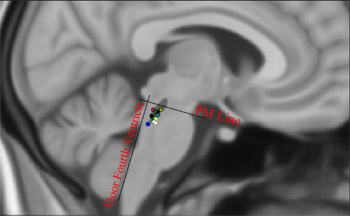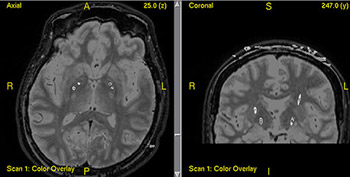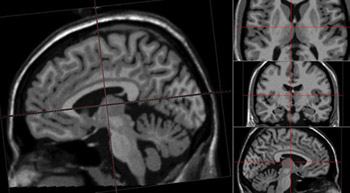RESEARCH
Our research aims to enhance the effectiveness of DBS. This includes fine tuning existing therapies and exploring new brain targets and stimulation strategies.
PROJECTS
 Pedunculopontine nucleus DBS for Parkinson’s disease
Pedunculopontine nucleus DBS for Parkinson’s disease
Pedunculopontine nucleus DBS is a promising new treatment for gait freezing and postural instability (poor balance) in Parkinson’s disease. However, so far, the impact of PPN DBS is very variable. We are refining the clinical method of PPN DBS to improve its effectiveness – by identifying which patients are likely to respond and the ideal location to implant electrodes.
Collaborators: Bionics Institute, Australia Pacific Centre of Neuromodulation, Australian Catholic University, University of Oxford
Funders: NHMRC, Brain Foundation, ACU Faculty grant
Closed Loop DBS for Parkinson’s disease using a Cochlear stimulator
Currently, DBS is ‘open loop’ - stimulation is set at the same level regardless of what the patient is doing. This means that at any particular moment, stimulation may be excessive or insufficient, resulting in side effects or incomplete benefit. We are therefore investigating ‘closed loop’ stimulation – where DBS is applied according to need, triggered by brain signal that reflect disease severity. This requires a sophisticated device to sense these signals and deliver stimulation at high resolution. This may be achieved by the advanced electronics used in Cochlear stimulators. A further advantage of Cochlear devices is their small size, which may allow implantation directly in the skull bone rather than in the chest wall.
Collaborators: Bionics Institute, Australia Pacific Centre of Neuromodulation, University of Oxford
Funders: Colonial Foundation
 Pallidal DBS for Dystonia
Pallidal DBS for Dystonia
DBS for dystonia can transform quality of life. However, the impact of DBS on dystonia is highly variable. We seek to clarify why this occurs. One focus has been the precise location of electrodes within the chosen brain target (the globus pallidus interna). Our preliminary results suggest that this has a substantial impact. Furthermore, that outcomes may be improved by employing novel patterns of stimulation to steer DBS, by relocating electrodes or by adding a second pair of electrodes.
Collaborators: University of Oxford
 DBS for drug resistant Epilepsy
DBS for drug resistant Epilepsy
For many patients with epilepsy, their seizures are not controlled by medication and they are unsuitable or have failed conventional surgery. For these patients, DBS may help. In a collaboration between major epilepsy units in Melbourne (at RMH, St Vincents and the Austin), we are assessing which patients with epilepsy are likely to respond to DBS – and how to tailor the choice of brain target to the individual.
Collaboration: Epilepsy Units at St Vincents, Austin and Royal Melbourne Hospitals
Funders: Medtronic
PUBLICATIONS
-
Fytagoridis A, Silburn P, Coyne T, Thevathasan W
Understanding the human pedunculopontine nucleus in Parkinson's disease
J Neural Transm (Vienna). 2016 Jan 16
-
Windels F, Thevathasan W, Silbum P and Sah P
Where and what is the PPN and what is its role in locomotion?
Brain, 2015 May; 138(Pt 5):1133-4
-
Beudel M, Little S, Pogosyan A, Ashkan K, Foltynie T, Limousin P, Zrinzo L, Hariz M, Bogdanovic M, Cheeran B, Green AL, Aziz T, Thevathasan W, Brown P
Tremor reduction by deep brain stimulation is associated with gamma power suppression in Parkinson's disease
Neuromodulation, 2015 Jul; 18(5):349-54
-
Joint CA, Thevathasan W, Green AL, Aziz TZ
Pallidal somatotopy suggested by deep brain stimulation in a patient with dystonia
Neurology, 2013 Feb 12;80(7):685-6 -
Thevathasan W, Cole MH, Graepel CL, Hyam JA, Jenkinson N, Brittain JS, Coyne TJ, Silburn PA, Aziz TZ, Kerr G, Brown P
A spatiotemporal analysis of gait freezing and the impact of pedunculopontine nucleus stimulation
Brain, 2012 May;135(Pt 5):1446-54 -
Thevathasan W, Pogosyan A, Hyam J.A, Jenkinson N, Foltynie T, Limousin P, Bogdanovic M, Zrinzo L, Green A.L, Aziz T.Z, Brown P
Alpha oscillations in the pedunculopontine nucleus correlate with gait performance in Parkinsonism
Brain, 2012 Jan;135(Pt 1):148-60. -
Thevathasan W, Coyne TJ, Hyam JA, Kerr G, Jenkinson N, Aziz TZ, Silburn PA
Pedunculopontine nucleus stimulation improves gait freezing in Parkinson’s disease
Neurosurgery, 2011 Dec;69(6):1248-53; discussion 1254 -
Thevathasan W, Pogosyan A, Hyam J, Jenkinson N, Bogdanovic M, Coyne TJ, Silburn PA, Aziz TZ, Brown P
A block to pre-prepared movement in gait freezing, relieved by pedunculopontine nucleus stimulation
Brain. 2011 Jul;134(Pt 7):2085-95 -
Eusebio A, Thevathasan W, Pogosyan A, Hariz M, Aziz T, Brown P
Deep Brain Stimulation can suppress pathological synchronization in parkinsonian patients
Journal of Neurology, Neurosurgery & Psychiatry, 2011 May;82(5):569-73. -
Thevathasan W, Schweder P, Joint C, Ray N, Pretorius P, Gregory R, Aziz T
Permanent tremor reduction during thalamic stimulation in Multiple Sclerosis
Journal of Neurology, Neurosurgery & Psychiatry, 2011 Apr;82(4):419-22
-
Thevathasan W, Squier W, MacIver D.H, Hilton D.A, Fathers E, Hilton-Jones D
Oculopharyngodistal myopathy - a possible association with cardiomyopathy
Neuromuscular Disorders. 2011 Feb;21(2):121-5. -
Astradsson A, Schweder P, Joint C, Forrow B, Thevathasan W, Pereira EA, Green AL, Aziz TZ
Thalamotomy for postapoplectic hemiballistic chorea in older adults
J Am Geriatr Soc. 2010 Nov;58(11):2240-1 -
Thevathasan W, Silburn PA, Brooker H, Coyne TJ, Khan S, Gill SS, Aziz TZ, Brown P
The impact of low frequency stimulation of the pedunculopontine nucleus region on reaction time in Parkinsonism
Journal of Neurology, Neurosurgery & Psychiatry, 2010 Oct;81(10):1099-104 -
Thevathasan W, Aziz TZ
Predicting falls in Parkinson’s disease – a step in the right direction (Commissioned editorial)
Neurology, 2010 Jul 13;75(2):107-8 -
Thevathasan W, Mazzone P, Jha A, Djamshidian A, Dileone, M, Di Lazzaro V, Brown P.
Spinal cord stimulation failed to relieve akinesia or restore locomotion in Parkinson’s disease
Neurology, 2010 Apr 20;74(16):1325-7 -
Thevathasan W, Gregory R
Deep Brain Stimulation for Movement Disorders (Commissioned review)
Practical Neurology, 2010 Feb; 10(1):16-26 -
Sauleau P, Eusebio A, Thevathasan W, Yarrow K, Pogosyan A, Zrinzo L, Ashkan K, Aziz T, Vandenberghe W, Nuttin B, Brown P.
Involvement of the Subthalamic Nucleus in engagement with behaviourally relevant stimuli.
European Journal of Neuroscience. 2009 Mar;29(5):931-42 -
Sheehy SHC, Lawrence T, Thevathasan AW
Serpentine Tongue: A Lingual Dyskinesia
Neurology 2008 May 20; 70 (21) -
Lim SY, Thevathasan AW, Gonzales M, Mitchell PJ, Evans A
Vasogenic oedema with no mass lesion
J Clin Neurosci. 2008 Sep;15(9):1048, 1075-6 -
Thevathasan AW, Davis SM
Temporal arteritis, Chapter two
Uncommon Causes of Stroke, Cambridge University Press 2008
